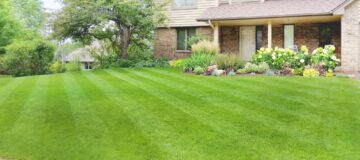Why We Love Our Lawns: A Brief History Of American Lawn Care
America’s love affair with our lawns is as passionate as ever. However, some things have changed—including our image of the ideal lawn. One person’s dream lawn may still be a green, weed-free turf worthy of a golf course and big enough for a John Deere riding mower. Others will be just as proud of their organic lawn that has a few weeds. Another family may be thrilled to welcome growing numbers of pollinators to their yard by installing a butterfly garden and a bee lawn.
Your lawn is the welcome mat to your home
While there’s no longer one single picture of the “perfect” lawn, the idea that our lawns reflect something about ourselves has endured. In fact, many people see their lawns as an opportunity to express their personal values. For some, a lawn may reflect a commitment to environmental stewardship. Others may prefer the familiar comfort of a green space with perfect lawn edging. Or, perhaps the time savings from a custom-tailored lawn to reduce watering and mowing needs is essential. Whatever our goals, our attachment to our lawns remains highly personal.

The history behind our love of lawns
Levittown, New York, is considered the birthplace of the suburban-style American lawn and garden. Built between 1947 and 1951, it set the standard for the explosion in suburban housing developments to follow. A large, well-kept lawn was a source of pride and came to symbolize a healthy, orderly community. In the years following World War II, home ownership became more affordable. Lawnmowers also became easier to use and less costly. Consequently, lawn maintenance emerged as a new pass time.
Have we come full circle?
Before we had lawns, people used whatever space they had in their yards to grow food and even keep livestock. After decades of expanding lots covered with turf, things are changing again. Recent years have seen the size of the average American lawn shrink.
Many factors have also changed attitudes about the ideal lawn. These include environmental awareness; builders placing bigger houses on smaller lots; homeowners’ desire to save time and money; and droughts resulting in watering restrictions and increased watering costs. In the popular urban homesteading movement, turf is replaced with vegetable gardens and fruit trees. People are even keeping beehives and chicken coops on city and suburban lots. Local ordinances have changed to meet the demands of residents seeking self-sufficiency and environmental goals.
Fun lawn facts:
- According to The Lawn Institute, a 5,000 sq ft grass lawn can produce enough oxygen daily for 16 people in Minneapolis!
- A 2016 study by the Metropolitan Council found approximately 20% of the Twin Cities’ treated drinking water is used for outdoor needs—mainly in landscaping and yards.
Lawn Goals: finding the perfect lawn for you
Need help creating your perfect lawn?
Other items you may be interested in:

Seeding Solutions
We offer a variety of personalized seeding solutions, including drought-tolerant and no-mow options.

Mowing Tips for Minnesota Lawns
Mowing your Minnesota lawn can seem like a daunting task. It can be time-consuming, requires owning and maintaining equipment, and small details like grass length

Bee Lawn
We offer a bee lawn service that includes a custom blend of grass and flowering perennials to attract pollinators to your yard.



